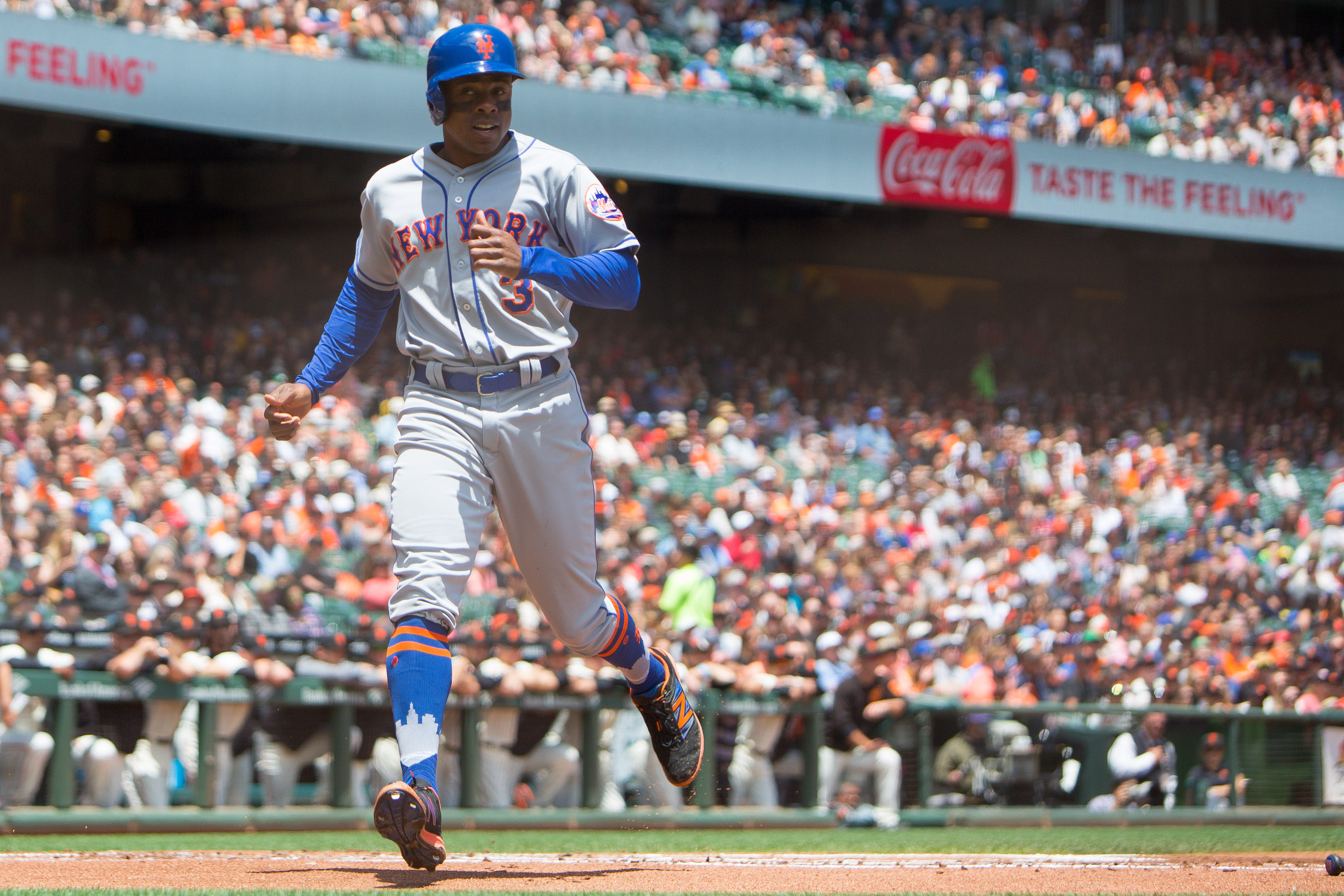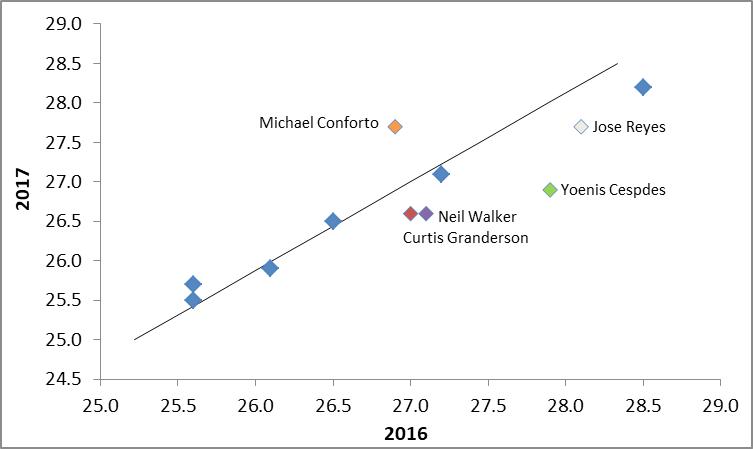Last month, Statcast released a new metric called “Sprint Speed” to measure how fast base runners move in feet per second around the bases. In particular, it looks at all batted balls (excluding over-the-fence home runs), and at plays where a runner or hitter attempted to advance two or more bases (excluding runners on second base for an extra-base hit, which typically doesn’t require full speed). The remaining runs are then sorted from slowest to fastest, and an average is taken of the fastest half. So, rather than stick with Terry Collins’ method of thinking Jay Bruce “might be faster than anybody on our team,” we decided to see how the Mets fare compared to the rest of the league as well as each other.
Comparison to the Rest of the League
While it might be recognized by most New York Mets fans that their team is slow, how slow actually are they compared to the rest of the league? This is not weighted by plate appearances though, which allows for some bias, but overall the Mets are one of the slowest teams in the league at not only each position but also overall. The only player who is near the top of his positional rankings is Travis d’Arnaud. Of course, none of this is particularly surprising given that the Mets frequently use pitchers as pinch runners.
| Position | Rank |
| C |
4 |
| 1B |
21 |
| 2B |
25 |
| 3B |
26 |
| SS |
18 |
| LF |
16 |
| CF |
20 |
| RF |
25 |
| Overall |
26 |
Year-over-Year Trends in Speed
With Statcast data on Sprint Speed available going back to 2015, fans can see the trends of the speeds of different players and compare them for the past three seasons. Not only are the New York Mets one of the slowest teams, but their key players seem to be getting slower. In the chart below, with the black line representing the line in which speed remains the same from 2016 to 2017, any player above the line has seen an increase in their foot speed while players below have seen decreases in their foot speed. The results make sense for the most part.
Unfortunately for the New York Mets, half of their starting lineup consists of players that have seen decreases in speed due to most likely a combination of age and injuries. In the age category is Jose Reyes, who 10 years ago would lead off for the Mets, was one of the faster players in the league and was a perenal threat to lead the league in stolen bases and triples. However, that was a decade ago and his age is showing. Not only is he no longer as fast as he used to be, hence he is tied in 18th place among shortstops in the majors, he also can no longer hit, making him a source of frustration for Mets fans. Another player past his prime is Curtis Granderson, who since 2015 has seen his speed around the bases decrease four percent from 27.7 feet per second in 2015 to 26.6 feet per second in 2016, dropping him below the league average overall. Not only is Granderson one of the slowest outfielders in all of baseball, he is actually the slowest center fielders in the majors, ranking dead last out of the 46 who qualify.
Two others Mets have shown rapid decreases from in their speed from 2016 to 2017, but these are at least partially due to injuries. Yoenis Cespdes is now 31 years old and slowing down is acceptable. However, losing one foot per second around the base paths is tied for the 10th largest decrease in all of Major League Baseball from 2016 to 2017. This is most likely not just due to age but also in part due to Cespedes’ hamstring problems that have hampered him in 2017. The other player that is potentially seeing a decrease in part due to injuries is 31-year-old Neil Walker, who is currently on the DL with a partial left hamstring tear. While he has only lost 0.5 feet per second, it is still a sizeable decrease.
There is one bright spot for the New York Mets in the data, though, as Michael Conforto has shown a decent increase in speed around the bases. Given that Conforto is still maturing as a baseball player in his sophomore season, and that he’s only 24, this seems pretty reasonable.
Limitations of the Speed Statistic
While this data is useful in a direct comparison of players against each other, it is difficult to justify if this is, in fact, the correct way to measure speed.The definition is that a player must attempt to advance two bases on a ball that is not a home run. However, sometimes a player won’t give maximum effort in those cases. On a ball hit to the outfield, a player might easily be able to advance from first to third but not give it his all. Another potential concern is that there is no currently granular data and hence other factors such as placement of the ball and situation are not factored in, all of which can be important in determining the effort that a player gives when running around the bases. As only aggregated data is available, there are also potential sample size problems as there is no way to see exactly how many observations there are for each player.
Despite all the potential limitations, the new speed data is potentially useful to fans. The ability to directly see how fast one player is compared to others is easy to understand and, while the data it isn’t perfect, it does give very reasonable results: who would have guessed that Billy Hamilton and Byron Buxton are the two fastest players in the league?
Potential Uses for Granular Data
While this data at an aggregate level is not as meaningful, teams, and particularly base coaches, should be able to turn the granular data into useful information. Knowing how diferent classes of players fare against outfielders based on their speed could be extremely useful in deciding whether to send a runner or not. For example, maybe Billy Hamilton could easily score on a sacrifice fly to Giancarlo Stanton but Curtis Granderson would have a much tougher time. And who knows, maybe Mets fans would be more willing to understand the past decisions of Tim Teufeul and Glenn Sherlock as third base coach if more data was available to support their decisions to have runners try to score. Or not.
Photo credit: Andrew Villa – USA Today Sports


Nice article on an under-reported topic. Unfortunately, the current Mets administration has never shown much appreciation for speed. Either offensive or defensive. Their mantra is OBP and power. Mets team speed will probably improve this offseason just because many of the older players will be gone.
Thank you. Yeah I will be interested to see this data going forward and seeing the data since I am sure it will change quite a bit next year once Bruce, Granderson and Cabrera are all potentially gone.